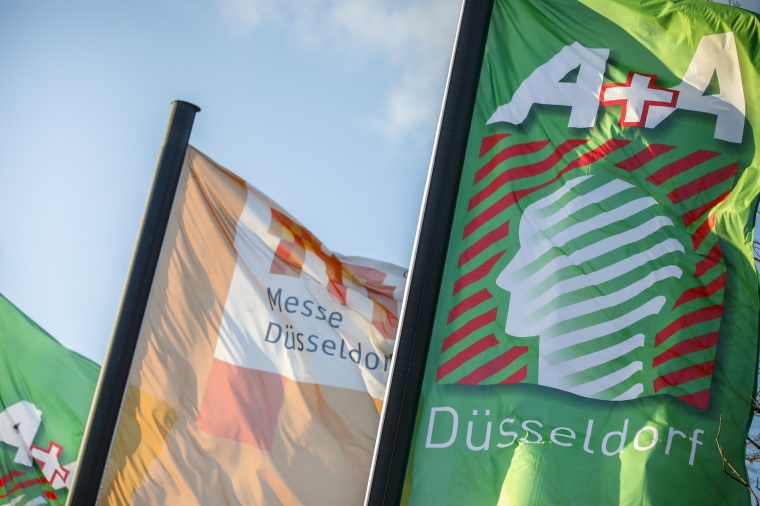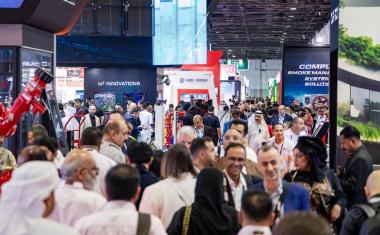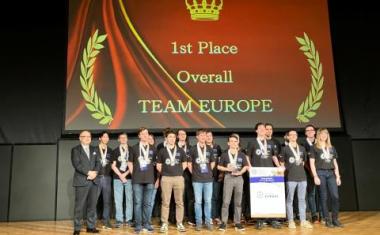A+A 2021: Fire Brigades and Digitalisation
For fire brigades digitalisation is especially helpful for operational preparation and education. The Covid pandemic and floods in the most recent past have shown that disasters first have to be met with robust technology, experience and leadership personality. But even drones provide more and more helpful services.

“In standard situations IT can support us well,” says Dr. Jörg Schmidt of the Technical University Cologne, Institute for Rescue Engineering and Emergency Response, and goes on to say: “Via a control room you can monitor operations and intervene if the status quo changes. But when the fire brigade is called it always is in a non-standard situation.” When floods have destroyed the infrastructure and there is neither power nor fresh water supply nor waste water disposal, heavy technical equipment needs to be used first to pave ways, save people and remain operational. “For bigger rivers there are IT simulations for floods. You can predict the water level, flood duration and flooded surface area,” says Schmidt. Cities like Cologne handle this routinely, have adequate headcounts to act professionally during major events. Since in Germany each local authority is independent, they are all also organised differently. And most volunteer fire brigades do not have sufficient manpower and means to effectively counteract situations like the floods in the Ahrtal valley right away.
Transfer to the hybrid mode during the stabilisation phase
In the most recent past we have seen highly dynamic crises such as fire, explosion or loss of containment and static crises such as the Covid pandemic. “Even though virtual situation briefings now work well physical briefings should be given preference in highly dynamic situations,” says Stephan Hummel, Head of Fire Protection at Currenta. “A video briefing on the state of affairs is faster to convene, that’s true – but it is not more effective or less stressful. Digital meetings reduce the ability to concentrate and the readiness to cooperate.” Currenta manages and operates the Chempark with sites in Leverkusen, Dormagen and Krefeld-Uerdingen. It is considered one of the biggest chemical industry estates in Europe. When the explosion occurred at the Leverkusen disposal centre in late July this year, the deployment of the factory fire brigade lasted three weeks: “From day five, that is after the structuring and stabilisation phase, we transferred to the hybrid mode in the normalisation phase,” says Hummel.
Operational briefings are held as web conferences. Location maps, operational logs with standard agendas and the strategic targets of central command as well as the corresponding measure tracking are done electronically.
When digitalised products fail
We also introduced some digital tools that were later de-commissioned again. “Such as the digital controls for pumps in the fire engine. Firemen could not handle the touchscreens so well – it proved rather difficult at 3 am after not having manned this vehicle for some time. Now we have our old control panel back with a lever and several buttons,” says Armin Wernick of Messe Düsseldorf’s fire brigade. A similar situation occurred with digital radio. It was down far too often. “Now we have purchased analogue technology again. For digital radio you need 100% connectivity otherwise it does not work. With analogue technology 60% suffices to communicate.”
Where digitalisation brings huge benefits
At Currenta digitalisation brings great advantages for the completely connected security centres with cross-site management in Leverkusen. The new control centre is equipped with an electronic emergency tool. In future fire fighters will be able to connect 100% with both the “back-office” operations control team and the command vehicle on site. Then amongst other things the situation maps and other relevant data can be projected on a smartboard attached to the outer wall of the vehicles.
Currenta now even has a digital twin of its three ChemPark sites – a virtual 3D image of the plants and the premises. “In this way you can obtain a comprehensive overview of the affected facility in the event of an incident,” says Hummel. The digital twin is developed further on a continuous basis. The more ops-relevant data is available in this system, which is immediately at hand in an emergency, the better the planning and the response in case of a disaster. The digital twin also helps to analyse processes and changes on the premises and better forecast developments.
Indispensable: VR training in education
In fire brigade training digitalisation is already more advanced – a fact considered urgently needed not only by Schmidt. “Demanding deployments are lacking – there are hardly any major fires these days.” Therefore, fire brigade trainees undergo training with the help of simulation the way aircraft pilots do.
This starts with blue light riding. “After all, you cannot simply switch on your blue lights while driving. Even driving on the airport premises can be simulated. In this way you can acquire experience regardless of the time of day and acquire route knowledge. You don’t even have to enter the premises for this anymore,” says Wernick. It is not only handling pumps inside the vehicle that can be trained virtually. The pump can also be studied from inside, broken down into its individual components and finally be completely re- assembled again. Handling of fire extinguishers is also taught with the help of VR technology; which also makes sense from an environmental standpoint because not every fire drill should end up emitting extinguishing foam into the environment. And like in rescue services you can also learn workflows via standard instructions and programs.
Support transfer of research into practice
Despite the efforts undertaken to drive digital information also in the firefighting sector there is still plenty of development potential. Drones for explorations and measurements already have a permanent place in fire brigade routine. The project partners of the “Deutsches Rettungsrobotik Zentrum e.V.” (DRZ – German Rescue Robotics Centre) in Dortmund, which has set out to pave the way for the transfer of research projects and new technologies into practice, has done reconnaissance flights with drones along the fault lines in the North Rhine-Westphalian flood areas, drawn up overview maps, and inspected houses, basements, vehicles and other objects. With the help of drone images 3D models of the devastated region were generated in the robotics command vehicle in order to spot any changes. And robots are also increasingly in use. Currenta uses a remotely controlled manipulator robot once the job gets too dangerous for humans.
Fire brigades have to remain operational even under the most adverse conditions. A failure of IT systems can only be compensated for by robust, fail-safe technology in future, too. This, however, should not be mistaken for a “digitalisation scepticism”. After all, the fire brigade is usually the last resort,” Hummel sums up. “This is why we need a robust technology today and a smart alternative to further leverage the benefits of digitalisation for fire brigades, with a view to managing deployments even more efficiently and effectively in future.” One step in this direction is the aforementioned new robotics command vehicle developed by scientists of the DRZ and experts of the Dortmund fire brigade. It is designed to serve research purposes and exercises for robot and drone trials but also support special deployments in future. Dirk Aschenbrenner, Director of Dortmund fire brigade and chairman of the non-profit association DRZ:
“For specific scenarios there will be a mixed team comprising DRZ project staff and firemen. Furthermore, we can use this research vehicle for ‘real’ emergencies. In this way, we as users acquire valuable experience that we can pass on to the researchers and developers. This is precisely one of the most important goals of the DRZ: bringing expert knowledge and user experience together.”
A+A 2021: experiencing trade fairs live again
From 26 to 29 October A+A 2021 will again stage special shows – hands-on and for joining in – an extensive programme of congresses and forums on the themes currently trending in the industry and offer the chance to enter into personal dialogue with experts.














